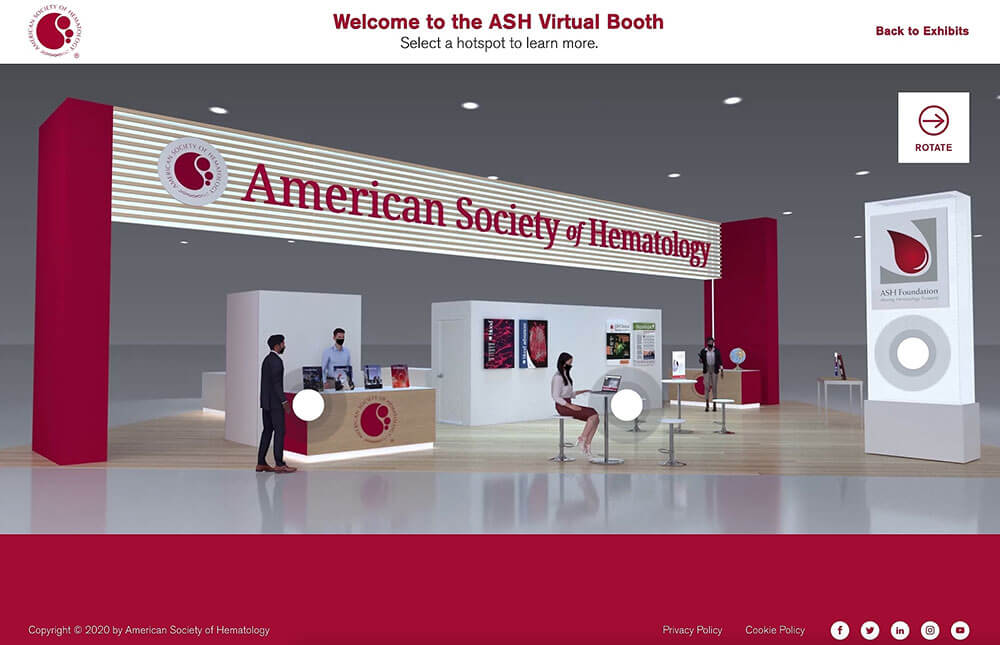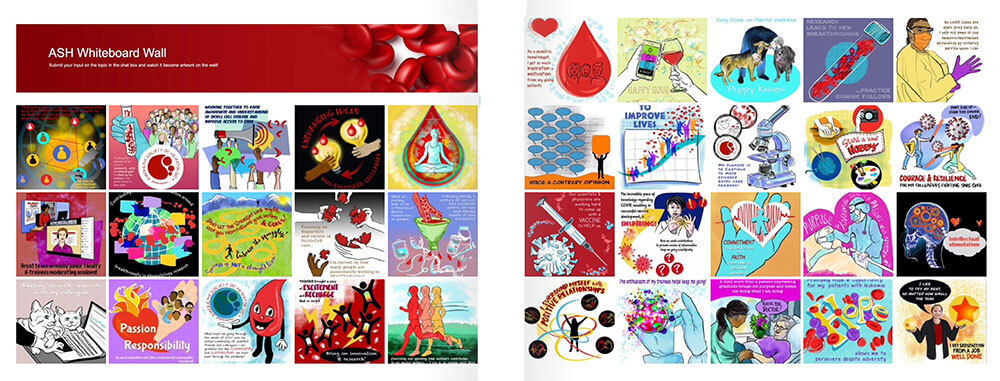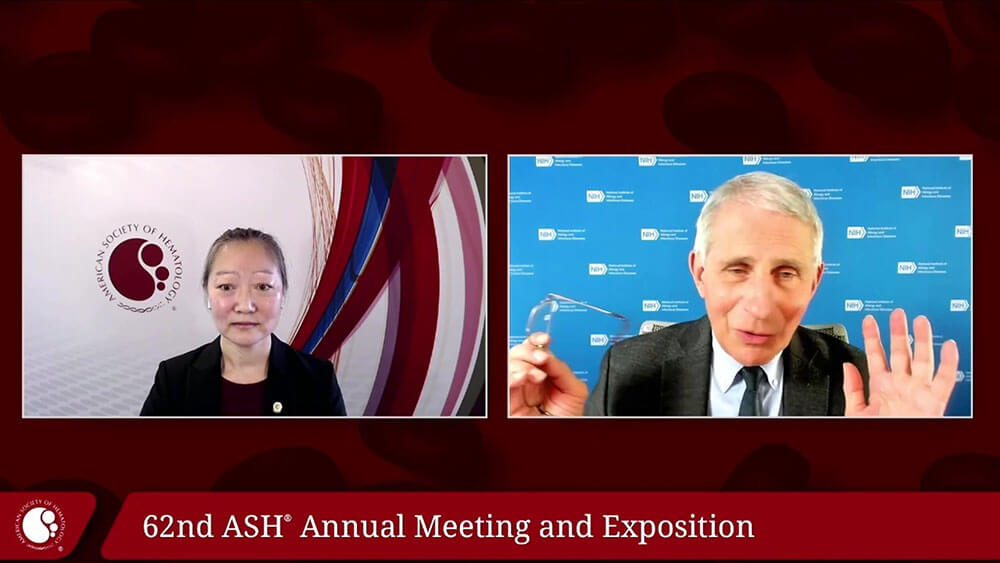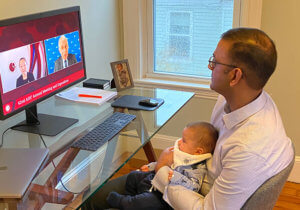
The ASH Virtual Booth was open for business throughout the event.
The American Society of Hematology (ASH) may be a nonprofit organization but “that’s a tax status not a business strategy,” said William F. Reed, FASAE, CMP, ASH’s chief event strategy officer. Reed started his career in hotel sales, and that background, he said, has enabled him to look at the revenue component of ASH’s events through a different lens. In addition, the 62nd ASH Annual Meeting and Exposition took place online Dec. 5-8, 2020, giving Reed and his team the opportunity to observe how other organizations were producing digital events throughout the year and time to think through potential business mod- els. Convene spoke with Reed in late February to learn how he and his team reengineered the annual meeting not as a short-term strategy but to make it a sustainable enterprise — and a more valuable experience for all participants — for the coming years.
It’s been a big challenge to make physical trade shows succeed on online platforms. How did ASH meet its sponsors’ objectives?
One of the things that I think we have done really well at ASH is asking exploratory questions — how will you, Company X, derive value from this experience, this investment? — and not assume that their answer is going to apply to any other company. We learned that everyone wants different data.
What kinds of data did you collect?
In 2020 and it’s likely to be the same in 2021 — and this could be specific to medical events — we found that the opportunity for these companies
to deliver educational content to the audience in an appropriate non-CME way had greater value because they had many more participants in the virtual environment. For example, our product theaters are typically limited to 150 participants when they’re in a physical space by sheer physical constraints. In the virtual environment, sponsors were able to have four times that attendance. They are very enthusiastic about opportunities like that.

Bill Reed, FASAE, CMP
As an example, that’s where they’re seeing greater value when compared to the virtual digital equivalent of the brick-and-mortar exhibit booth. I think we have — everyone has — work to do on driving participants to the booth. We also learned that companies themselves may have allowed policies that they created in a hurry in the shift to digital to restrict the generation of value, but maybe we’ll see some modifications to those policies in 2021.
I’ll give you an example, which may be specific to pharmaceutical companies. Obviously, the dialogue between a physician and a company representative is highly regulated, highly sensitive. In a physical environment, someone walks into the exhibit booth and they have a conversation with a representative. That’s all verbal — there’s no enduring documentation of what was discussed. Yet, in the virtual environment, if the connection mechanisms are a video chat, a text exchange, or an email exchange, now you’ve got a permanent record of what was and wasn’t said. That makes the compliance and regulatory implications of that simple networking more complicated.
As a result, some companies elected to turn off the features that were built into the virtual meeting platform that allowed the physician to have a one-on-one conversation with them, because they believe a record of that exists somewhere. Technically, it does, although I don’t know actually where it resides. They set these policy restrictions that certain types of their staff could not have access to those tools within the platform, so we honored that and turned them off. For other companies that didn’t have the policy — or perhaps didn’t have it yet — we kept those tools engaged. There you started to see bifurcation of the value proposition from the exhibit component — I found that fascinating. I’m watching it closely with other medical meetings. At the end of the day, that’s impacting the investment equation.

The ASH Whiteboard Wall brought ideas shared by participants to visual life at the virtual annual meeting.
Were those online product theaters synchronous or asynchronous or a combination?
We allowed each company to make a determination. That too was something we learned along the way — some companies wanted to deliver a livestream and did not want an on-demand version of the event. Again, it all goes back to the compliance and the regulations — and also dated material. If something occurred after the livestream event, you wouldn’t want old data available when there’s fresh data available. That was an interesting learning.
We also were pleased to learn that the education grants that many medical societies receive from pharmaceutical companies, the companies continued to provide those so that financially we were able to deliver the virtual meeting successfully. In 2021, we’ll again watch this space because if a company normally gives X dollars for the in-person meeting, we did not see them reduce that amount because the delivery method was virtual.
Everyone’s talking about paring back your content for your virtual event. We went with a different strategy. Part of our value proposition for the meeting under normal circumstances at ASH is that you can go broad with your education and cover the latest updates on many different disease states or you can go deep into just one of those, depending upon what your learner needs are. We continued to go broad and allow someone to go deep in one through the virtual. We eliminated some of the add-on things, but we were still delivering a commensurate level of education and perhaps that’s why companies decided not to change the dollar amount.
Did you change the length of sessions?
For medical meetings, we have an embargo in play for many sessions. For the sessions that the scientific presentations are not subject to an embargo, we experimented with the format for certain sessions. We had speakers prerecord their scientific presentation for that. We allowed people to preview those presentations in advance so they could kind of do their homework before that session. In a session with three speakers, you heard what the three speakers wanted to say about the science. Then, we reduced the live- session time period from 90 minutes to 60 minutes and, in some cases, to 45 minutes, but made the assumption the audience has already listened to the three scientific presentations so that the scheduled session became about an executive summary that the moderator provided, just in case someone didn’t watch the prerecorded content so they could get the gist of it. That enabled us to have more time for live Q&A, which everyone wants the most of anyway.
We did those as livestreamed in real-time. Many of our speakers are international. That necessitated some of them doing that in the middle of the night their local time. They were willing to do that, thank goodness. That was really well-received. In fact, we’re going to replicate that newly discovered format in 2021 at our annual meeting in Atlanta, for both the virtual audience as well as the in-person audience.
What we believe is the people who attend in person in 2021 will want to maximize the time spent interacting informally. Shortened sessions for them when they’re at the in-person meeting means they’ll have an extra 30 minutes to talk to others or just have more flexibility. In that hybrid meeting format, what we decided to do is eliminate the first time slot at 7 a.m. or 7:30 a.m., which is not necessarily conducive for virtual meeting participants when you look at the time-zone conversions. The participants who are in Atlanta at the in-person meeting might do more breakfast meetings or meet colleagues for coffee. We’re also offering additional product theater timeslots during that early morning time period.
Can you tell us about the virtual walk-through of the poster session?
At scientific meetings, the notion of a poster walk is not novel. What is novel is the virtual delivery of it. After the core meeting dates, we have poster walks where ASH selected six posters that were unique and all related to each other. Then, we assembled key opinion leaders to take participants on a journey to “see” those six posters and comment about how they’re related, what they think that means to practice. In addition to an individual maybe exploring a whole swath of posters on their own, a group of key opinion leaders — experts in that particular area of hematology — presented poster walks on different topics in a virtual environment after the meeting. It created additional exposure for those posters.
Then, we took that concept and thought, “Well, a company might have a desire to take participants on that same type of walking journey.” Granted, they have a commercial interest and a bias in the selection. We intentionally separated the two programs and named them completely different things so that the audience member clearly understood whether it was a commercial interest poster walk or an ASH-curated poster walk. The feedback was really good, and again, gave a company a new way to promote the science but also invest in the meeting because they paid for that opportunity.

ASH President Stephanie J. Lee, MD, MPH, chats with National Institute of Allergy and Infectious Diseases Director Anthony S. Fauci, MD, during the 62nd ASH Annual Meeting.
How many registrants did you have in total?
Here’s the thing that I’m really happy about. We set a new attendance record and we charged an appropriate price for it. Many organizations that provided registration for free had really significant growth. To me, that says what we’re doing, the content that we’re delivering, is on target and is the result of the reputation we earned beforehand. So, because we’re in a strong position at delivering value, people came in higher numbers. The growth was in international participants. We had a decline in U.S.-based attendance, we believe because the United States was in the middle of a COVID surge in December and many of our U.S.-based hematologists were treating patients and dealing with the surge and couldn’t come.
We had more than 30,000 attendees and that number is growing — people are still registering for the meeting because the platform is still accessible. We have three different options for people to gain access to the content. They can buy access to the virtual meeting platform and watch on demand. They can buy Webcast which is essentially the same thing without the networking component, without the exhibit component, or they can attend some of our virtual highlights of ASH meetings that normally take place in January, February, and March. Again, we’ve created three different price points between those three different offerings.
What else did producing your first all-digital event teach you?
I think many event organizers are struggling with the business model shift. Having end-to-end responsibility in my position — I’m responsible for top-line revenue and bottom-line net income — is extremely helpful because when the business model shifted, I’ve got accountability for revenue and expenses. I think that’s a growth opportunity for many in the profession — if one’s responsibility is the service delivery and expense-focused only, this is an opportunity to expand the skillset to look at the continuum of the business model. How do you bring in money? If you don’t bring in the top-line revenue, it’s impossible to have anything left over after expenses.

ASH participant Vijay Sankaran, MD, Ph.D., tweeted, “Enjoying Dr. Fauci and #ASH20 at home!”
I think the opportunity is there to really understand the dollar value worth of one’s meeting. We knew going into it in 2020 that our pricing strategy was more about 2021 through 2025. Many organizations provided their digital education for free, nearly free in the association world, or free or severely discounted for members only. But it’s very hard after the initial shock of the pandemic and everything that we were experiencing especially for the early-on organizations, to go from free to sustainable pricing. We spent a lot of effort trying to assess the right balance between the two, knowing that 2020 was probably just an interim approach. We wanted to start a journey of the value proposition and being able to charge an appropriate price after 2020. I think we did that really well.
This is where you’ve got to understand your audience behavior before the pandemic. We knew there’s a portion of our audience that is not price sensitive. We were able to apply price elasticity to our approach. Here’s where having business acumen really assisted and not being afraid to write down a number that might get pushback. We knew that by pushing the envelope, we might get some negative feedback. We all agreed that we could always reduce the number — no one would complain about that. But if you price too low, you can’t go up if they were willing to pay more. For the portion of our audience that is not price-sensitive — like a Wall Street person who comes to the meet- ing to learn about the science that’s going to impact drug prices and stock prices — we had higher-priced options that they were most likely to purchase.
We also wanted to protect our trainee attendees, early-career stage, from the perspective of wanting to make it an inclusive meeting. We wanted to make sure that price was not a roadblock for them. We had options on the lower end of the scale and many different price points in between the two. We staggered the price point based upon the length of time that they would have access to the virtual meeting’s content. If you were price-sensitive, you could buy a seven-day subscription, meaning you could experience the meeting when the meeting was going on. For a little bit more, you could buy a 30-day subscription and be able to watch sessions on demand after the meeting was over for a little bit more time. We offered a 90-day subscription for those who weren’t price-sensitive. Each person could select an option that fit their situation best. What we learned was some people bought the seven-day pass but as the seven-day expiration date came up, they upgraded to the 30-day to extend their access; the 30-day upgraded to the 90-day.
We’ll utilize that approach in the hybrid as well even for the in-person participants. They will have access to the virtual meeting platform when they’re in Atlanta. That’s how we’re going to connect someone in Madagascar with the hematologist who is in Atlanta. They, too, will need to make a decision. How long do they want access to the digital component after the meeting? That’s going to shape the price point. That was a business model shift that we took a risk with. We also used that length-of-time approach as the differentiator for exhibiting companies as well. Their price points varied based upon how long they have exposure on the platform. The big companies wanted the greatest amount of exposure and they bought the highest-priced packages as a result of that. We knew there were companies that would want the lower-priced options because they’re more constrained in that way.
Normally, when companies are buying their booths, it’s based upon real estate and the number of square feet. It’s not about real estate in the virtual environment. We thought, “What is the new metric that separates a large purchase versus a small purchase?” We came up with the concept of time.
Each exhibiting company chose what they wanted to expose. For instance, there are some companies that kept all the networking components going after the event so if you wanted to have a conversation with a representative, you still could. Others wanted to turn that off because they didn’t have the staff available to monitor the traffic.
Any additional takeaways from the virtual event?
One thing that was very different in virtual that I struggled with was that for the in-person delivery, when you’re on-site, when you’ve got a reasonable amount of experience, you can tell when something is about ready to go wrong in advance of it going wrong. You can steer it in a different direction and modify the approach in the moment.
In the virtual meeting space, there’s no early warning system. It just smacks you in the face. You have got to react quickly and have the communication channels in place to get everyone focused on, “Okay, drop what you’re doing. We got to fix this right now.” The communication aspect cannot be underscored enough.
That said, I feel like 2020 was my best career year ever. I feel guilty feeling that way but it reminds me of all the work I’ve done in the years and decades that prepared me for this moment. That’s really gratifying. I’ve thought more about the people who helped me early on in my career and how grateful I am. If you have a sense of gratitude even in these difficult times, if you can say, “I would do it all over again in a heartbeat,” well, that.’s where I’m at. Good thing, because 2021 is going to be even more difficult.
A Different Membership Model
ASH operates very differently than many associations, Reed said. “We do not drive all of our product offerings to encourage people to become members. That’s not the goal. Membership is something we offer but if you attend the meeting as a non-member, we’re perfectly fine with that because you have to qualify for membership at ASH — you just can’t write a check and become a member. You have to meet certain criteria. You have to do it early on in the year so you can’t buy membership in order to get a meeting discount four weeks from the meeting. We have far more non-members attending our meeting every year and we love that. They stay engaged with ASH. They pay the higher price.”
Which begs the question: What’s the value in becoming a member of ASH? Reed said that it’s a matter of prestige and professional recognition. “You’re in a smaller circle of a bigger community. You have access to other leading hematologists,” he said. “We believe that what really matters the most is if I’m a physician in leukemia, if I can be in a smaller pond of leukemia experts around the world, and I’ve got access to that smaller group through membership — that’s the reason why I become a member.”
‘The Best Leader I Could Possibly Be’
When he reflects on 2020, Reed thinks about the importance of leadership. “As I look at my career, when I evaluate myself as a leader, 2020 is probably going to be the year where I feel like I was the best leader I could possibly be,” he said. “It required having a vision and helping people along the way connect their contribution to that collective vision. Checking in with people over and over to assess how they’re feeling, if they’re struggling with things. As a leader, getting the obstacle out of the way. That included our volunteer leadership and keeping them apprised probably more than we normally would so that there were no surprises. For me, the leadership and taking risks appropriately was really the thing that I will remember the longest.”
Part of leadership, Reed acknowledged, is that people have to follow. “It was extremely gratifying to me to know my colleagues had faith and trust in the vision, that they were willing to go along even when we got tangled up in areas where we didn’t all universally agree. At the end of the day,” he said, “you’ve got to make a decision and move forward.”
Michelle Russell is editor in chief of Convene.
